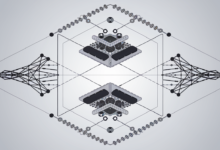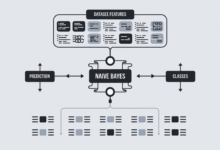
Understanding Gradient Descent
Gradient Descent is an optimization algorithm widely used in machine learning and deep learning. It aims to find the parameters that minimize a cost function, ensuring the model predicts as accurately as possible.
A gradient measures how the output of a function changes if you tweak the inputs slightly. In gradient descent, this gradient guides a model towards minimizing error. The process starts with defining an initial set of parameters. From this point, the algorithm calculates the gradient to decide which direction leads towards the error minimum. It then iteratively adjusts the parameters to step closer to the optimal values, reducing the cost function, or error, with each move.
The cost function measures the difference between the actual and predicted output, surfacing the error. Gradient descent works to minimize this error. Each step in this algorithm involves computing the gradients of the cost function. The algorithm updates the parameters by subtracting a fraction of these gradients, which is controlled by the learning rate.
Choosing the right learning rate is crucial. Too high, and the algorithm might overshoot the optimal values. Too low, and it will make tiny steps, taking longer to reach the goal. The ideal learning rate ensures the model converges quickly and accurately to the point of minimal error.
To calculate the gradient, the derivative of the cost function is determined. This derivative points in the direction of the steepest ascent. The gradient descent algorithm moves in the opposite direction, ensuring a descent towards lower cost values.
There are three popular variations of gradient descent:
- Batch Gradient Descent processes the entire training dataset before updating parameters. While it ensures stability, it's slower for large datasets.
- Stochastic Gradient Descent (SGD) updates the parameters for each training example one by one. This frequent updating speeds up convergence but might add noise and instability.
- Mini-batch Gradient Descent strikes a balance by updating parameters after processing small subsets of the data. It combines the stability of batch gradient descent with the speed of SGD.
Parameters' updates follow the rule: new_parameter = old_parameter – learning_rate * gradient. This rule iterates until the cost function stops decreasing, and the model converges to its optimal state.
Implementing gradient descent in practice often involves defining the model, the cost function, and a loop to iteratively adjust the parameters until convergence. This hands-on approach helps solidify the theoretical understanding while optimizing model performance.
In essence, gradient descent continuously adjusts parameters towards the minimum of the cost function. This iterative, mathematical process ensures the model predicts as accurately as possible, refining it to optimal performance.
Variants of Gradient Descent
Different scenarios might call for different types of gradient descent. Batch Gradient Descent is particularly useful for small to medium-sized datasets where computational efficiency isn't a bottleneck. It provides a stable error gradient, giving a clear path to convergence. However, when dealing with extremely large datasets, processing the entire dataset in one go can be resource-intensive and time-consuming, leading to prolonged training times.
Stochastic Gradient Descent, on the other hand, is faster because it updates the model parameters after each individual training example. This approach injects noise into the parameter updates, which can help the model avoid local minima and potentially find a more optimal solution. Yet, the trade-off is volatility—because the updates are frequent and based on one example at a time, the error rate can jump around more than with batch gradient descent. This requires careful management of the learning rate to avoid erratic convergence.
Mini-batch Gradient Descent offers a middle ground. By updating parameters after a small subset of examples, mini-batch gradient descent balances the frequent updates of SGD with the more stable updates of Batch Gradient Descent. This provides a compromise between speed and stability and often results in better overall performance. Commonly, mini-batch sizes range from 50 to 256 samples. With modern hardware like GPUs, this method maximizes computational efficiency due to parallel processing capabilities. It's a preferred method for training deep neural networks where balancing computational load and convergence speed is critical.
Understanding these variations helps in choosing the right technique depending on the specific problem at hand. For instance:
- When quick learning is paramount and computational resources are abundant, Stochastic Gradient Descent might be employed.
- Conversely, for scenarios where minimizing oscillations in parameter updates is crucial, Batch Gradient Descent could be favorable.
- Mini-batch Gradient Descent stands as a versatile method, widely adopted in various applications due to its balanced approach.
Ultimately, the choice of gradient descent variation can significantly impact the efficiency and effectiveness of training a machine learning model. The synergy of algorithm choice with the practical constraints and goals ensures that gradient descent remains an effective optimization technique, adapting to the requirements of each problem it encounters.
Challenges in Gradient Descent
Gradient descent, for all its efficacy, isn't without challenges. One notable issue is the phenomenon of vanishing and exploding gradients. This occurs primarily in deep neural networks where gradients calculated during backpropagation can become extremely small or exceedingly large. When gradients vanish, the network's weights update too slowly, stalling the learning process. Conversely, exploding gradients lead to unstable updates, with parameters changing too abruptly, causing the model to diverge rather than converge.
Choosing an appropriate learning rate is another critical challenge. A learning rate that's too high can cause the algorithm to overshoot the optimal values, introducing instability and preventing convergence. A too-low learning rate, on the other hand, makes the training process sluggish, requiring many iterations to make significant progress towards the minimum error.
The issue of local minima also complicates gradient descent. The optimization landscape in machine learning, especially for deep networks, can be riddled with local minima—points where the cost function is lower than its immediate surroundings but not the lowest point overall. Gradient descent algorithms can become trapped in these local minima, failing to find the global minimum and thus not achieving the best possible performance.
To mitigate these challenges, several techniques are employed:
- Weight Regularization: This approach penalizes large weights by adding a regularization term to the cost function, discouraging the optimization from settling on overly complex models that may not generalize well. Regularization can be applied as L1 (Lasso) or L2 (Ridge) norms, each influencing weights differently to prevent overfitting and help in traversing the optimization landscape more smoothly.1
- Gradient Clipping: When dealing with exploding gradients, gradient clipping is a practical solution. This technique involves scaling back the gradients during backpropagation so they don't exceed a predefined threshold. By capping the gradients at a certain maximum value, gradient clipping ensures that the updates remain stable, preventing the erratic jumps that can derail the learning process.2
- Batch Normalization: This method tackles both vanishing and exploding gradients by normalizing the inputs of each layer within a mini-batch. By standardizing the inputs with a mean of zero and a variance of one, batch normalization stabilizes the learning process. It helps in maintaining a consistent scale of inputs to the next layers, leading to faster convergence and enabling higher learning rates without the risk of divergence.3
- Adaptive Learning Rates: Algorithms like AdaGrad, RMSprop, and Adam adjust the learning rate dynamically throughout training. These adaptive learning rates allow the model to converge faster and more efficiently. They help in mitigating the risks of choosing a suboptimal fixed learning rate, adapting to the specific requirements of each parameter's updates.
By understanding and addressing these challenges, gradient descent algorithms can function more effectively, enhancing the overall performance of machine learning models. The diligent application of these mitigation techniques ensures that the iterative journey towards the optimal model configuration traverses the optimization landscape efficiently, avoiding common pitfalls and converging to a point of minimal error.
Advanced Gradient Descent Techniques
Moving beyond basic gradient descent, several advanced techniques have been developed to enhance the optimization process, each addressing specific shortcomings. These methods include:
- Momentum-based Gradient Descent
- Nesterov Accelerated Gradient (NAG)
- Adagrad
- RMSprop
- Adam
Momentum-based Gradient Descent builds on the concept of inertia from physics, aiming to accelerate the gradient vectors in the right directions and dampen oscillations. Instead of relying solely on the gradient of the current step, it also factors in the accumulated gradients of past steps. This approach helps in speeding up convergence, particularly in cases where the cost function exhibits a long, narrow valley.
Nesterov Accelerated Gradient (NAG) takes the momentum approach a step further by looking ahead into the future position of the parameters. Instead of calculating the gradient at the current position, NAG evaluates it at the anticipated future position. This 'lookahead' strategy gives more accurate adjustments.
Adagrad (Adaptive Gradient Algorithm) changes the learning rate dynamically based on the frequency of parameter updates. Parameters updated frequently get smaller learning rates, while infrequent updates get larger ones. This dynamic adjustment makes Adagrad particularly effective for sparse data or natural language processing tasks. However, Adagrad's learning rate decay can become excessively slow over long periods.
RMSprop addresses this issue by introducing a moving average over the squared gradients, which smooths the updates. This modification allows RMSprop to maintain an adaptive learning rate that's suitable for non-stationary objectives and performs well on recurrent neural networks.
Finally, Adam (Adaptive Moment Estimation) combines the benefits of RMSprop and momentum. Adam calculates both the exponentially weighted moving averages of past gradients (momentum) and past squared gradients (RMSprop). It also introduces bias correction to counteract the initialization bias of the moving averages. With default parameters, Adam adapts the learning rate based on both the gradient's momentum and its variance, making it highly effective in practice for various deep learning applications, especially when dealing with sparse gradients and non-stationary targets1.
In summary, these advanced gradient descent techniques enhance the optimization process's performance, robustness, and convergence speed. Selecting the appropriate method based on the specific characteristics of the problem and the data assures that machine learning models are not just accurate but also efficiently optimized.
Practical Implementation of Gradient Descent
Let's delve into implementing gradient descent using Python and PyTorch to solidify your understanding with practical application. This guide will provide code snippets, detailed explanations, and visualizations to illustrate the optimization process effectively.
To start, we'll need to import the necessary libraries. PyTorch is our go-to for building and training neural networks, and Matplotlib will help us visualize our results.
For this example, we'll create synthetic data that includes some inherent linear relationships to clearly illustrate the optimization process. Let's imagine we are building a simple linear regression model.
Next, we define a simple linear regression model using PyTorch. We'll use Mean Squared Error (MSE) as our loss function, which is common in regression problems.
To showcase gradient descent manually:
- Initialize the model's parameters (weights and bias).
- Define the learning rate and the number of iterations.
- For each iteration:
- Forward pass: make predictions using the current parameters.
- Calculate the loss using MSE.
- Backward pass: compute gradients of the loss with respect to the parameters.
- Update the parameters by subtracting the learning rate multiplied by the gradients.
- Visualize the loss over iterations to observe the optimization process.
After training, we can check the model's learned weights and biases by comparing these values to our true weights and bias, verifying how well the model has learned.
We can now make predictions using our trained model.
This hands-on guide demonstrates how gradient descent can be implemented practically using Python and PyTorch. It highlights key steps such as defining the model, loss function, and iterative parameter updates while providing visualization to track the optimization process. This approach is essential for applying gradient descent to real-world machine learning tasks, ensuring a comprehensive understanding of both theory and practice.
Recent Advances and Research in Gradient Descent
Recent advancements in gradient descent have propelled the field of machine learning optimization to new heights, focusing on the intricate details of step sizes and the convergence efficiency of these algorithms. One notable study by Das Gupta, an optimization researcher from MIT, delved deep into the step size optimization of gradient descent algorithms, posing a significant challenge to conventional wisdom2. Using innovative computer-aided proof techniques, Das Gupta tested more varied step lengths and found that contrary to the long-held belief, a sequence of gradient descent steps, carefully crafted, could outperform standard methods with uniform small steps.
Prompted by these findings, another researcher, Grimmer, extended this exploration by crafting a more generalized theorem. By running millions of simulations to understand the optimal sequences over more extensive iterations, Grimmer unearthed a fascinating pattern. The sequences that converged most efficiently shared a peculiar feature: the largest step was positioned in the middle. For different length sequences, this central step varied but stayed notably prominent—highlighting an almost fractal-like repetition of smaller steps surrounding a large, pivotal one.
These insights stretch beyond the confines of smooth, convex functions—the primary focus of Grimmer's research. In practical applications, machine learning often grapples with non-convex functions riddled with sharp kinks and multiple minima. While current advanced techniques like Adam and RMSprop provide adaptive learning rates customized to such challenges, the theoretical breakthroughs in step size optimization introduce new avenues for improving even these complex scenarios.
Future research will likely explore how these patterns can be implemented in non-convex optimization problems. By integrating larger, intelligently placed steps within established adaptive methods, researchers might enhance the robustness and speed of convergence for neural networks. This could be particularly transformative for deep learning tasks that require traversing multi-dimensional error landscapes.
These advanced theoretical insights, backed by empirical evidence, reiterate the value of continuous innovation in optimization algorithms. They serve as a catalyst for further investigations, pushing the boundaries of what can be achieved in the realm of gradient descent and machine learning at large. As researchers probe deeper into the nuanced mechanics of gradient descent, the landscape of machine learning optimization promises to be more efficient, accurate, and adaptable than ever before.
By appreciating the intricate balance of step size and sequence, these recent advancements highlight yet another layer in the complex, dynamic field of gradient descent—a testament to the continual evolution and refinement driving machine learning forward.
Gradient Descent remains a vital tool in optimizing machine learning models, continuously improving their accuracy and efficiency. By grasping its nuances and advanced techniques, one can significantly enhance model performance, making it an indispensable part of the machine learning toolkit.
Let Writio, the AI content writer, bring your website to life! This article was written by Writio.








